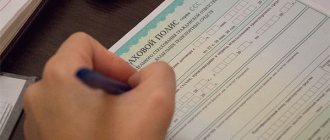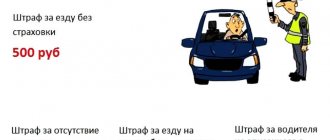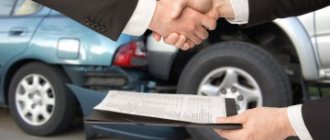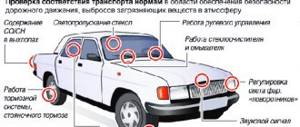What is depreciation?
Depreciation according to OSAGO is the depreciation of vehicle spare parts received during its operation. This parameter is used by insurers to reduce payments under insurance policies and is legal. The thing is that in the event of an accident, most of the car’s spare parts are not new, which means that their market value before the accident is lower than that of a new car (read about how to calculate the cost of spare parts according to compulsory motor liability insurance on the RSA website). As a result, when calculating the insurance payment, insurers do not pay 100% of the average market value of the part, but somewhat less.
What is car wear and tear
Vehicle wear and tear is the process of physical aging of a vehicle under the influence of various external and internal factors. Using wear parameters for a specific car and its individual elements (engine, transmission, chassis, etc.), the current condition of the car is assessed. Vehicles gradually wear out as they are used.
The main reasons for wear include:
- physical and chemical changes in car elements;
- deformation changes in materials;
- fatigue of metal parts;
- the appearance of corrosion processes;
- mileage;
- car class;
- intensity of machine use;
- terms of Use.
Car depreciation for compulsory motor liability insurance in 2021 and 2021. has a direct impact, because the amount of payments for auto insurance by insurers is made precisely taking into account depreciation - it determines the maximum amount the owner can receive based on the results of the examination. In any case, it will be less than what the car owner paid when buying a new car.
Important! If in 2015 a person bought a new car for 500,000 rubles, then taking into account wear and tear in 2021, its value will fall by 20-30%, therefore, if the car owner is injured in an accident, then he will receive a seriously reduced amount from the insurance company. And this is completely legal.
Legislative regulation for insurance companies
The legality and legality of wear and tear under compulsory motor liability insurance is regulated by two legislative documents:
- Article No. 12 of Federal Law No. 40, as amended in 2017, which introduces the concept of mandatory “motor citizenship”.
- Chapter No. 9 of Government Resolution No. 263, which regulates compulsory car insurance. The amount of accrued depreciation is regulated by another document: Appendix of the Central Bank of Russia No. 432-P. This document was adopted in 2014. The described method of calculating depreciation under MTPL is mandatory for use by insurers, their employees and independent expert appraisers.
How to control your insurance
Everyone knows that car repairs, especially when completely replaced with new auto parts, can cost a lot of money. If there is no harm caused to the driver’s health, then MTPL compensation is paid in kind.
But it often turns out that a compulsory insurance contract does not bring any benefit, since the amount at which experts evaluate the vehicle often does not correspond to reality. And that’s when the insurance compensation is not large enough and you have to go to court.
When a contract is concluded under compulsory motor liability insurance, the insurer has an obligation to conduct an examination and assess the damage to the damaged car. Appraisers who cooperate with the insurance company try to downplay the size of the incident, thereby reducing the amount of compensation.
If the difference between the actual damage and the estimated damage is obvious, then you can request a calculation or conduct your own independent examination. Remember that RSA car insurance and the calculation of the cost of OSAGO spare parts are carried out according to a single methodology.
Therefore, try to check not only the calculations, but also check all the dates, because an incorrectly entered date of start of operation can seriously affect the amount of compensation.
How and by whom is it considered?
A legal calculation of depreciation under compulsory motor liability insurance, which has legal force, can only be data obtained from a certified expert agency, with which the insurance company must necessarily enter into an agreement.
At the same time, you need to understand that in the vast majority of cases, the insurer does not turn to the services of such agencies and calculates depreciation independently. This is not illegal if the insurance company does not issue an official opinion on this issue, but only uses an independent calculation to determine the amount of insurance compensation.
Pay
Let's go back to the fact that the amount of insurance compensation has a limit. Any payments under compulsory motor liability insurance, with or without wear and tear, are made only after the damage has been assessed by specialists. Naturally, in the event of damage to the victim’s property along with bodily injuries (harm to health), the insurance company of the initiator of the car accident is obliged to pay the full cost of repairs and treatment.
Under compulsory motor liability insurance, payments are made without taking into account transport tax. The cost of materials and spare parts falls entirely on the shoulders of the insurance company. If, taking into account the calculation of car wear and tear, the allocated amount of compensation does not cover all your losses, you can file a complaint with the insurance company.
If they have a justified reason for the refusal, the missing part of the money must be compensated by the culprit of the accident in court.
Formula and coefficients
The depreciation of car parts under compulsory motor liability insurance can be calculated independently or using online calculators to calculate insurance payments, taking into account the percentage of depreciation. Each of these methods will be discussed below. So, in order to calculate depreciation on a vehicle license using an online calculator, you will need to enter the following data:
- vehicle release date;
- date when the accident occurred;
- type of vehicle;
- vehicle mileage as of the date of the traffic accident;
- Tire tread height on the date of the accident.
By entering all the above data, you can get the total wear of car parts, wear of the car battery and wear of tires. To calculate the wear and tear of a car yourself, you will have to use the formula that is determined by the unified calculation system established by the Central Bank of Russia.
To calculate wear, you need to raise 2.72 to a power, the value of which is equal to - (ΔT*Tki+ΔL*Lki), where:
- ΔT – coefficient determined by the service life of the machine.
- Tki – years during which the car was operated.
- ΔL – coefficient determined by the vehicle mileage.
- Lki – kilometers traveled by the car.
The resulting value must be subtracted from 1 and multiplied by 100 .
The resulting value will show the wear of parts as a percentage.
The parameters ΔТ and ΔL deserve special attention. Their values must be determined from the table below.
| Type of vehicle | ΔT value | ΔL value |
| VAZ, UAZ, GAZ, TagAZ, ZAZ | 0,057 | 0,003 |
| Brilliance, BYD, Chery, Derways, FAW, Geely, Great Wall, Hafei, Haima, Lifan, Luxgen, Xin Kai | 0,057 | 0,0029 |
| Aston Martin, Bentley, Bugatti, Ferrari, Jaguar, Maserati, Porsche, Audi, BMW, Mercedes-Benz, Mini, Rover Alfa Romeo, Citroen, Fiat, Ford, Opel, Peugeot, Renault, Saab, SEAT, Skoda, Volkswagen, Volvo | 0,042 | 0,0023 |
| Acura, Buick, Cadillac, Chevrolet, Chrysler, Dodge, Hummer, Infiniti, Jeep, Lexus, Lincoln, Mercury, Pontiac | 0,045 | 0,0024 |
| Daewoo, Hyundai, Kia, Ssang Yong, | 0,052 | 0,0026 |
| Toyota, Mitsubishi, Daihatsu, Honda, Isuzu, Mazda, Nissan, Subaru, Suzuki, | 0,049 | 0,0025 |
| Freight vehicles | 0,077 | 0,0023 |
| Buses | 0,113 | 0,0008 |
| Trolleybuses and trams | 0,098 | 0,0008 |
| Trailers for trucks | 0,09 | 0 |
| Trailers for cars | 0,06 | 0 |
| Motorcycles | 0,07 | 0 |
| Agricultural, fire, construction and other special equipment | 0,15 | 0 |
The full formula for calculating compulsory motor liability insurance and a table of all coefficients can be found in this material.
What documents need to be submitted?
How to get a referral for repairs under OSAGO? After the occurrence of an insured event and its registration in accordance with current legislation, the insurance company is provided with:
- notification of a traffic accident or a certificate from the traffic police about an accident;
- copies of the protocol on the administrative offense and the corresponding resolution;
- certificate of no need for criminal prosecution;
- copies of the passport and driver's license of the owner of the vehicle;
- copies of compulsory car insurance policies for the culprit and the victim;
- application for insurance payment.
At the next stage, the damaged car is inspected by experts and a report is drawn up, which is subsequently attached to the insurance case.
After receiving the examination and making a decision to recognize the accident as an insured event, the car owner is given a referral for car repair to a certain organization.
After the referral is issued, an agreement is concluded between the insurance company, the repair organization and the owner of the vehicle, which specifies the following parameters:
- list of works necessary to restore vehicles;
- cost of work determined using a unified methodology;
- repair deadlines.
The repair is considered completed if:
- the owner of the car receives ready-made vehicles;
- the owner signs the vehicle acceptance certificate.
If the car owner is not satisfied with the quality of the repairs performed, there is no need to sign a report, but rather deal with the insurance company.
Restoring a car under compulsory motor liability insurance is a good alternative to monetary compensation for damage, as it saves the owner from the time spent searching for a company, purchasing spare parts, and so on.
However, it is recommended to be extremely careful when choosing a repair organization. Small companies with unqualified employees may produce poor-quality repairs.
The application form for insurance payment under MTPL can be found in the article: application for an insured event under MTPL. Where is the best place to insure a car under MTPL, see the page.
Find out the amount of the fine for not having a compulsory motor liability insurance policy from this information.
Which car parts are subject to accrual and which are not?
Depreciation under compulsory motor liability insurance is charged on all vehicle spare parts, except for the list specified by law. This list includes the following:
- Airbags for driver and passengers.
- The seat belt and all its components.
- Components and assemblies of pneumatic, electronic-pneumatic and hydraulic brake systems.
- Steering wheel control components and assemblies.
- Components and assemblies of the vehicle clutch system.
Is it possible to receive a TTS payment for repairs under OSAGO?
Yes, you can. Despite the fact that the insurance company pays for repairs directly to the car service center, the victim can receive payment from the TSA in cash.
This was clearly indicated by the Supreme Court of the Russian Federation in paragraph 37 of the Plenum on OSAGO:
Loss of marketable value is also subject to compensation if insurance compensation is carried out under a compulsory insurance contract in the form of organizing and (or) payment for restoration repairs of a damaged vehicle at a service station.
What to do if the insurance company underestimates payments?
Cases where insurers overestimate the wear and tear of parts are not uncommon. This is due to the fact that the goal of any player in the insurance market is to make a profit , whatever they say in their advertising. Unfortunately, practice shows that in negotiations with the policyholder, the insurer does not accept arguments regarding the incorrect calculation of wear and tear. The only option left to the policyholder is to go to court.
But there is one serious pitfall: the lawsuit will have to be accompanied by a conclusion from a certified company that is allowed to conduct such examinations, and these are additional costs, which, if won, will fall on the shoulders of the insurance company, and if the claim is not satisfied, will remain additional costs for the insured.
Please note: After filing an application with the court, a hearing will be scheduled at which the judge, after listening to the opinions of the parties, will order a third examination at the Chamber of Commerce and Industry or a similar government agency.
It is on the basis of the conclusions of these experts that a verdict will be rendered on the claim for review of wear and tear under OSAGO. In general, depreciation under compulsory motor liability insurance is a variable that has an exact calculation formula, which does not prevent insurers from trying to deceive policyholders by overstating depreciation or applying it to parts to which it cannot be applied by law.
Therefore, every vehicle owner needs to understand the depreciation formula so that he can check the correctness of the calculation of this variable and, if necessary, go to court to restore justice.
In order to be sure of the correct calculation of insurance and payments for it, we suggest that you familiarize yourself with the following information:
- tariffs for compulsory motor liability insurance and its calculation;
- how to calculate an electronic MTPL policy using an online calculator;
- driver class and its impact on the cost of insurance;
- how to calculate the loss of marketable value of a car;
- how to calculate the amount of payment under compulsory motor liability insurance in case of an accident;
- how to calculate damage using the RCA database.
Law on wear and tear of vehicles under compulsory motor liability insurance
Depreciation for compulsory motor liability insurance is discussed in the “Insurance Rules”, which were approved by the Central Bank of Russia. In particular, it says the following: “The insurance company, when determining the amount of costs for restoring a car, is obliged to take into account the wear and tear of parts, mechanisms, electrical equipment and other elements of the car. The amount of expenses for spare parts should be established taking into account the wear and tear of components that are subject to replacement during the process of restoration and repair work. Moreover, component parts cannot be subject to depreciation of more than 50% of their original cost.
Article on the topic: Payment for compulsory motor liability insurance policy via the Internet











